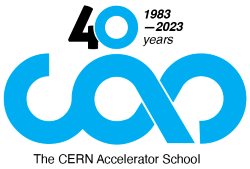The design, construction, and operation of accelerator magnets, particularly those employing superconductor technology, pose
challenges in all domains of physics and engineering. These challenges include: Material science aspects, such as the development of superconducting wires and cables, the specification of austenitic and magnetic steel, and the choice of radiation-resistant insulation....
Instead of asking what are vector fields, or what is the difference between the magnetic field intensity H
and the magnetic flux density B, it is more meaningful to ask what they do or describe: Vector fields are mappings that assign to each point of the domain, one and only one bound vector from the domain's tangent space. Electric fields, represented by the gradient of a scalar field,...
Instead of asking what are vector fields, or what is the difference between the magnetic field intensity H
and the magnetic flux density B, it is more meaningful to ask what they do or describe: Vector fields are mappings that assign to each point of the domain, one and only one bound vector from the domain's tangent space. Electric fields, represented by the gradient of a scalar field,...
The main purpose of the lecture is to explain the real use of all main magnet types in different accelerators. For this a one hor primer on linear beam optics is included. Folloing the theoretical model application examples of dipole, quadrupoles, sextupoles, solenoids and other magnets are given.
The main purpose of the lecture is to explain the real use of all main magnet types in different accelerators. For this a one hor primer on linear beam optics is included. Folloing the theoretical model application examples of dipole, quadrupoles, sextupoles, solenoids and other magnets are given.
Instead of asking what are vector fields, or what is the difference between the magnetic field intensity H
and the magnetic flux density B, it is more meaningful to ask what they do or describe: Vector fields are mappings that assign to each point of the domain, one and only one bound vector from the domain's tangent space. Electric fields, represented by the gradient of a scalar field,...
After a brief recap of the derivation of field harmonics, this lecture delineates the process of creating multipoles with current lines, focusing particularly on dipoles and quadrupoles. The presentation covers the derivation of ideal dipolar and quadrupolar fields, as well as more realistic cases such as sector coils and canted cos-theta configurations.
Superconducting magnets create very high magnetic fields thanks to their intrinsically large current densities. As a consequence, large electromagnetic forces are created. Obviously, support structures are needed to hold these forces without degradation. Futhermore, as a specific feature of superconductors, proper support of the coils is necessary to avoid premature quenches. This lecture...
The lecture shows the methodology for assessing the maximum performance of dipole and quadrupole magnets. This involves introducing and explaining concepts such as critical surface, filling ratios, peak field on coils, load line, and short sample. It also delves into additional considerations regarding the influence of the iron yoke and current grading.
After a short introduction aiming at reviewing the physical parameters of superconducting materials, families of the cuprates (REBCO, BSCCO 2212 and BSCCO 2223), MgB2 and Iron Based Superconductors are described. Emphasis is put on their structure, on their physical properties, including vortex pinning characteristics, and on the manufacturing processes that enable production of wire and/or...
Superconducting magnets create very high magnetic fields thanks to their intrinsically large current densities. As a consequence, large electromagnetic forces are created. Obviously, support structures are needed to hold these forces without degradation. Futhermore, as a specific feature of superconductors, proper support of the coils is necessary to avoid premature quenches. This lecture...
Low emittance rings are accelerator facilities of increasing importance nowadays. Both damping rings for linear colliders and storage rings of 4th generation light sources belong to this category. Magnets for these type of rings share demanding and specific features: high field strength, good field quality, narrow tolerance alignments. There are some particular magnets to which special...
Field maps, i.e. cartographic descriptions of the magnetic field, are used to assess the field quality in accelerator magnets, for various applications. Due to their capability to measure static magnetic fields, and their comparatively small active areas of less than 1 mm2, mapping techniques are based on Hall probes as magnetic field sensors.
This lecture begins with an introduction to the...
The production of superconducting magnets for accelerators is a complex and not yet fully industrialised process. Ensuring the reliable performance of these magnets in accelerators requires meticulous engineering across a diverse range of specialties. In this lecture, after a brief historical overview of accelerator magnets design and construction, we review the main manufacturing steps for...
The production of superconducting magnets for accelerators is a complex and not yet fully industrialised process. Ensuring the reliable performance of these magnets in accelerators requires meticulous engineering across a diverse range of specialties. In this lecture, after a brief historical overview of accelerator magnets design and construction, we review the main manufacturing steps for...
A brief introduction to the superferric magnets is given, what are they and why we use them.
An overview of the use of superferric magnets in synchrotrons by selected examples from past to actual projects. A special focus is dedicated to HL-LHC high Orde Correctors with a detailed description of the design and performance, highlighting the contribution of the superferric configuration.
The...
